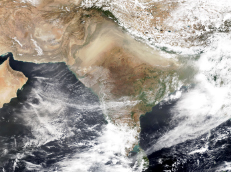2018–19 Grants
The following are summaries of the research grants awarded:
Global Mapping of Cropping Seasonality
Jennifer Burney, Associate Professor, GPS, UC San Diego

This project uses Sentinel and Landsat satellite imagery to map the seasonality of crop production – how many crops are produced each year and when – over the entire globe. The newer Sentinel data is the basis for a higher resolution current product, while the longer-running Landsat data provides a time series to understand how cropping intensity has changed over time. Detecting these changes is vital for understanding how much multiple cropping potential exists to help agricultural regions adapt to environmental changes and Burney notes it also provides a mechanism for estimating irrigation water use – a critical adaptation technology about which we have very little information worldwide. This project was in collaboration with FEMA and Google Earth Engine.
Land Use and Environmental Management
Jennifer Burney, Associate Professor and Susanne Benz, Postdoctoral Scholar, GPS, UC San Diego
In addition to our greenhouse gas emissions that have warmed the atmosphere, human transformations of Earth’s surface have dramatically altered the surface radiation balance. Urbanization often leads to heating, and vegetation and irrigated agriculture can cool the surface, although these impacts vary across space and time. Burney and Benz are mapping the world’s surface temperature heterogeneity, and using basic geophysical models to understand how much is attributable to human activity. This project will help us understand how much human settlement patterns will magnify or mitigate the global temperature changes that are already baked in from past emissions, and can thus be used to guide adaptation investments.
The Cost of Air Pollution in India
Teevrat Garg, Assistant Professor, GPS, UC San Diego

The project aims to analyze the impacts of air pollution on firms in India, which has one of the highest concentrations of air pollution in the world, with 13 of the Earth’s 20 most polluted cities. Government action has been slow, in part, because the full costs of air pollution are not properly understood. Using atmospheric thermal inversions that increase the concentration of local pollutants as an instrument, Garg proposes to examine how India’s rapidly deteriorating air quality impacts worker and firm productivity as well as infant mortality. The research should shed light on the economic cost of poor air quality in India to provide a benchmark for cost-benefit analysis of proposed environmental regulations. The project will rely on newly available satellite-based reanalysis products on air quality and thermal inversions.
The Economic Consequences of Infrastructure Investment in India
Gordon Hanson, Professor and Hogeun Park, Postdoctoral Scholar, GPS, UC San Diego
While India has experienced significant infrastructure development over the last few decades, our understanding of economic and societal impact of new infrastructure is still limited. By synthesizing novel techniques such as remote sensing imagery analysis, computational modeling and econometrics, they quantified the economic impact of road development in India. To understand the dynamics of economic development, they synthesized multiple remote sensing products to define urban markets and their growth. Hanson and Park developed a market accessibility database across multiple years through computational modeling that enabled them to analyze the relationship between infrastructure development and economic changes in multi-spatiotemporal scales. This project is in collaboration with Columbia University.
The Economic Consequences of Hurricanes
Gordon Hanson, Professor and Hogeun Park, Postdoctoral Scholar, GPS, UC San Diego
Hanson and Park seek to find out how neighborhood characteristics differently affect socioeconomic recovery after extreme climate events (e.g., Hurricane Irma, Harvey, etc.) in this research project. They teamed up with New Light Technologies, Columbia University, and National Aeronautics and Space Administration (NASA) to bring interdisciplinary perspectives to the research. To untangle the complex relationships among multiple factors affecting the recovery, they synthesized socioeconomic data and remote sensing products. Based on this research, they aimed to understand not only a trend of recovery but also a big picture of regional disparity and climate vulnerability.
Domestic Institutions and Free Trade Agreements: Parliamentary vs. Presidential Systems
Megumi Naoi, Associate Professor, Department of Political Science, UC San Diego
Do democratic political institutions affect the depth of trade liberalization and the profile of products that are liberalized? This project shows that a parliamentary system of government facilitates “substitution bargain,” where executives exchange promises of redistributive compensation for legislative support for ratification. Specifically, parliamentary systems mitigate information and commitment problems in substitution bargain as the same actor (i.e., executives are legislators in parliamentary systems) negotiates a trade agreement and domestic compensation (i.e., budget), leading to deeper trade liberalization during economic booms and among geographically-concentrated products. By contrast, this bargain is difficult to strike and enforce in presidential systems where the two distinctive branches negotiate a trade agreement and budget, leading to deeper liberalization during economic downturns and among geographically-discussed products. This project tests this argument using new data on product-level trade liberalization across all preferential trade agreements. As an identification strategy, Naoi leverages overlapping trade agreements whereby democratic countries with two different political institutions sign a trade agreement with a common trading partner. GPS students were hired to code institutional and procedural features of compensatory budget-making in Japan, South Korea, the U.S. and Mexico as well as the timeline of trade negotiations relative to the timeline for compensatory budget decisions.
